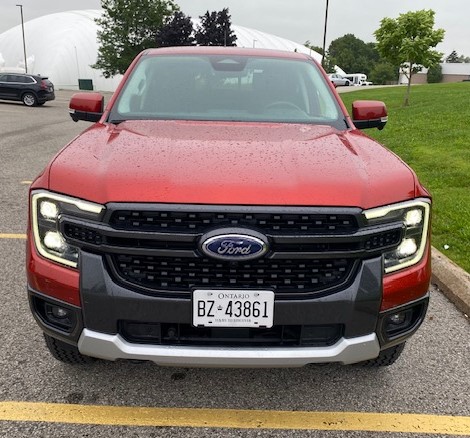
Neat frontal styling of the Ford Ranger pickup
History
Prior to its termination at the end of the 2011 model year, the Ranger name was appended to a cheap and cheerful compact pickup truck beloved by contractors and private buyers seeking an inexpensive ride. After a long hiatus, Ford reprised the Range name for the 2019 model year, but not its previous frugal concept; the new truck was much larger and expensive. Ford renewed the Ranger for the 2024 model year.
Model mix
Most Rangers will be powered by a turbocharged 2.3L four rated at 270 horsepower. Two turbocharged V6 engines, a 2.7L-V6 and a 3L-V6 are available Only one body style, a crew cab with a five-foot cargo box, is offered.
| Vehicle tested | 2024 Ford Ranger Lariat 2.3 T |
| Body style | Crew Car pickup truck |
| MSRP as tested | $58,565 (includes spray-in bedliner, FX4 off-road package, advanced tow package, splash guards, floor liners and optional paint |
| MSRP spread | $41,870 – $ 77,945 |
| Engine | 2.3 L-4 turbo (270 horsepower) |
| Transmission | 10-speed automatic |
| Drive system | Four-wheel drive |
| Observed fuel economy | 16.5L/100 km |
Styling
The new 2024 looks little different from its predecessor that was released for the 2019 model year. Gentle evolution is typical of the pickup truck market, so the incremental styling change is not unexpected. The Ranger is a neat styling job, cleaner and smoother than busier, edgier and boxier rivals like the Colorado-Canyon from GM, Nissan Frontier and Toyota Tacoma.
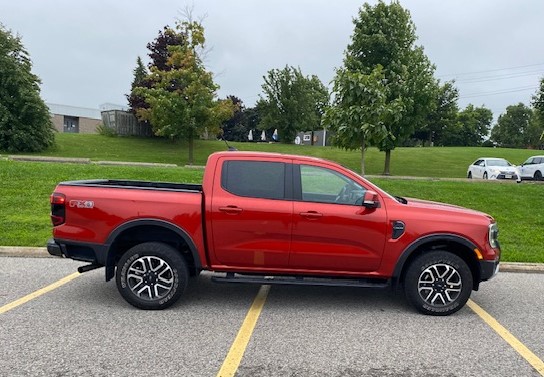
Seek profile compared to the competition
Interior
The driver faces a crisply-marked digital display. The tachometer is oddly marked, with number 1.2 representing 1200 rpm. Bizarre. The centre of the cluster features a configurable digital display, above which are digital gauges for water, oil and transmission temperatures, and fuel level. The centre of the dashboard is dominated by a massive, vertically-oriented screen that that controls most infotainment functions. The screen also includes icons for radio, audio, and trailer controls, as well as touch icons for air distribution, seat heaters, defrosting and temperature. Fortunately, there also are physical knobs for the climate controls and an audio on-off and volume knob.
The cabin of the previous-generation Ranger looked a bit cheap; the new model is a definite step up. Plastics are matte finish and our high-end Lariat model boasted soft-touch surfaces on the dashboard and the tops of the front doors. There are some good-looking faux-alloy accents and the leather seating on the Lariat is attractive.
The front seats are comfortable. The rear seat is supportive and legroom is sufficient for adults. Access to the rear seat is reasonable. The rear seat cushion rotates up against the seatback to liberate floor space for cargo. There are two storage bins under the rear cushion. The front and rear doors all have water bottle slots. The front doors have small door bins, with more generous rear door bins. The console houses large cupholders and a massive bin under the front armrest. Rear seat riders enjoy lots of ports for electronic devices.
The cargo bay is five feet in length, with relatively small wheel arch intrusions, though the one on the driver’s side has a protrusion at its forward end.
The tailgate is light and easy to close but the hood requires an energetic slam to latch properly.
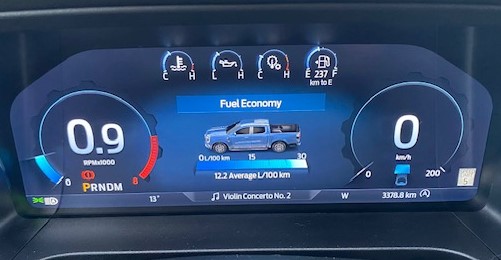
Crisply-marked digital gauges. Oddly marked tachometer.
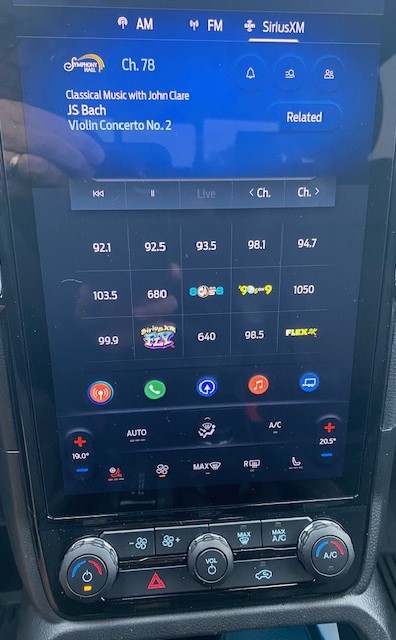
Massive screen works well. Physical controls for climate functions are appreciated.
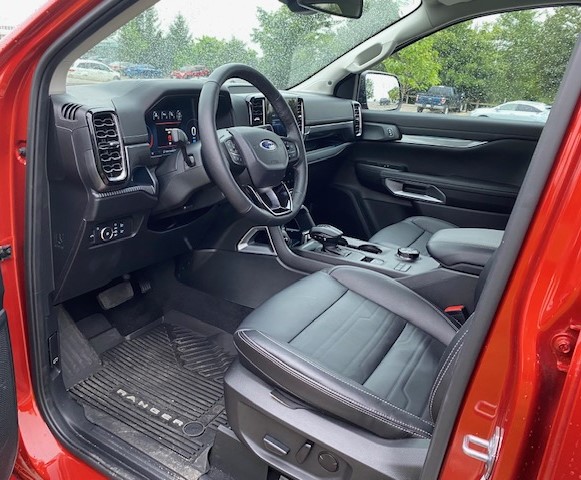
Traditional design allies with good room to create a comfortable cabin.
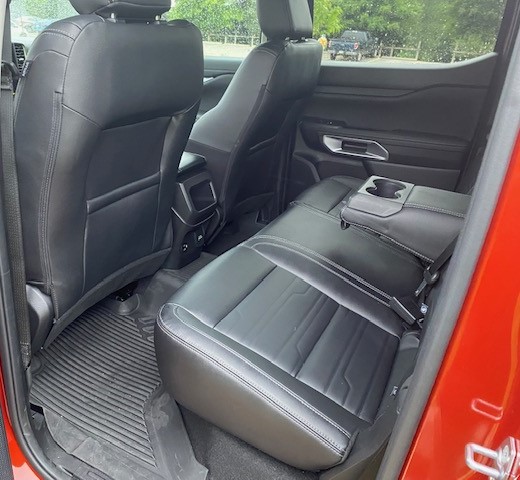
Rear seat space is greater than in other trucks in this segment
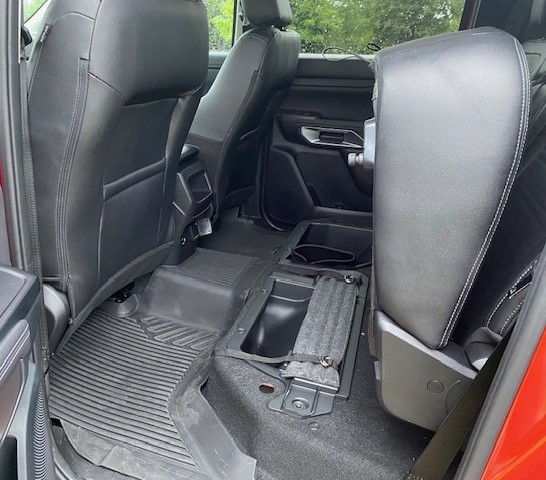
Rear seat folds up to liberate floor space
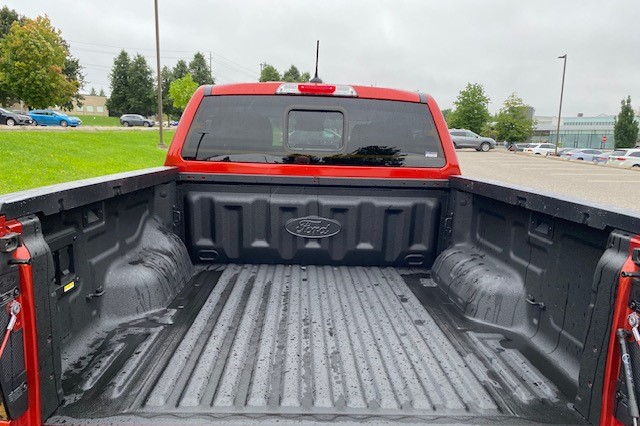
Our Ranger featured a spray-in bedliner. The tailgate is light and easy to manipulate
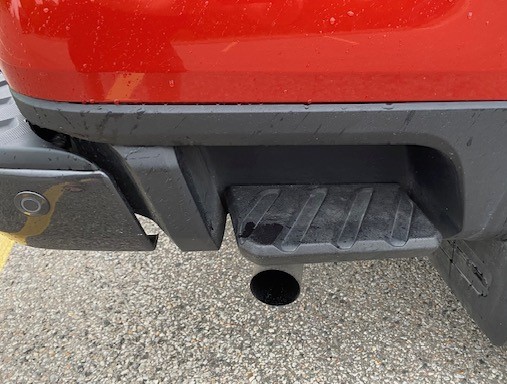
Built-in step makes access into the cargo bed easy
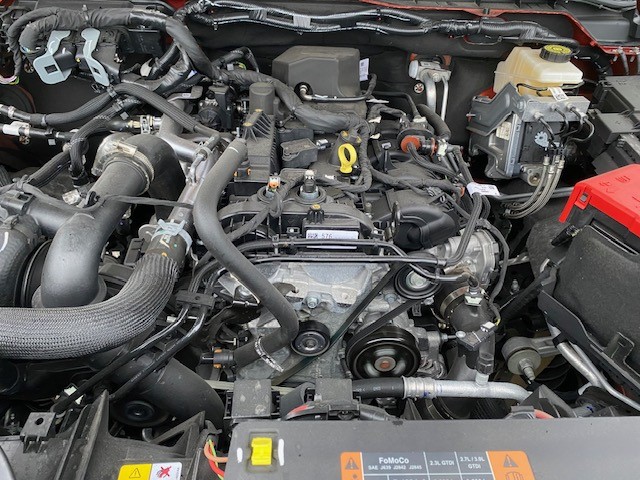
2.3 L turbo four is smooth, flexible and thirsty
Performance
The 2.3L turbo four that powers the Ranger is a delight. Power delivery is strong and linear and the engine is quite refined. It’s likely more of a testament to soundproofing than to mechanical quietness, as this engine can be raucous in other Ford vehicles. Unfortunately, along with great power comes great thirst, with observed fuel economy of 16.5L/100 km during our week with the truck.
The 10-speed automatic transmission is engaged via an electronic selector, the shift pattern for which is obscured by your palm when you try to select a gear. The transmission upshifts well, but downshifts are occasionally harsh.
Steering is nicely weighted and holds its line well on the highway; however, steering inputs feel non-linear. Except on very smooth pavement, the Ranger’s ride is surprisingly turbulent for a vehicle built on a long 128-inch wheelbase. Handling is predictable, but the height, weight and suspension compromises needed for the truck to be stable with a big load or while towing don’t add up to an engaging driving experience. The suspension is rated to carry up to 776 kilograms and towing up to 3400 kilograms.
Air conditioning performance was impressive during sultry weather. The Bang & Olufsen branded audio system delivers a pleasing sound quality.
Pricing
The crew cab body style, with four forward-hinged doors, is the sole cab style offered on the new-generation Ranger. Four-wheel drive is standard on all trims. The base XL is equipped with L.E.D. headlights, fog lights, forward collision warning and autonomous emergency braking. Moving up to the XLT adds power-fold mirrors, L.E.D. cargo bed lighting, a manually-operated rear window, deep-tint glass, blind spot and rear cross traffic monitors, a lane-keeping assist system, floor mats, wireless cellphone charging and remote starting, but is a bit overpriced. The Lariat upgrade includes parking sonar front and rear, power front seats, active cruise control, leather seating, ambient cabin lighting, rain-sensing wipers, a garage door opener, active parking, a B&O audio system and lit vanity mirrors, but is priced beyond the value of its content.
Leasing offers very good value this year.
Like GM’s Colorado-Canyon twins, even the cheapest variants of the Ranger are very expensive and the price escalates quickly as you add features. These so-called “Midsize” trucks are now priced beyond what many people are able to pay, which may relegate the Ranger to a limited niche market, as the smaller Maverick is Ford’s value proposition and uprating to the F150 doesn’t cost all that much more if you’re willing to choose your features carefully.
Conclusions
Though it bears the Ranger nameplate, the current truck is in no way a replacement for its cheap and cheerful predecessor, sales of which ceased in 2011. The current Ranger, though worthy enough, is notably expensive, approaching the prices that were commanded by a similarly-equipped F-150s five years ago.
The current Ranger, though worthy enough, is expensive, with prices that were commanded by similarly-equipped F-150s five years ago. Although it’s larger that the “classic” Ranger that was discontinued after 2011, the Ford Maverick is a more direct replacement for the original Ranger. In practical terms, unless you need the higher load bed rating and towing capacities of the Ranger, the Ford Maverick is likely a better choice. Cabin space of the Maverick is similar, and the load bed is only six inches shorter. As a unibody design, the Maverick, with carlike ride, handling and steering, is much nicer to drive, unencumbered by the necessity to remain stable when carrying bigger payloads in its cargo area. The available Maverick hybrid is quick, quiet and very economical, a far cry from the profligate fuel use experienced with the Ranger 2.3L turbo driven by the APA. That said, the Maverick, once reasonably priced, has itself become quite expensive. There is definitely space at the bottom of the pickup market for a less expensive compact truck that would be appealing to a wider range of pocketbooks.
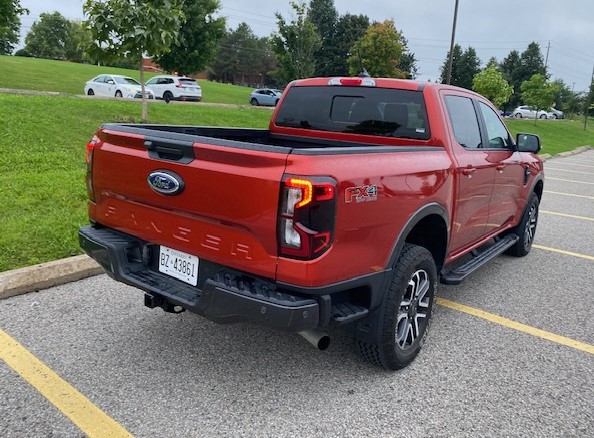
Slick rear styling
